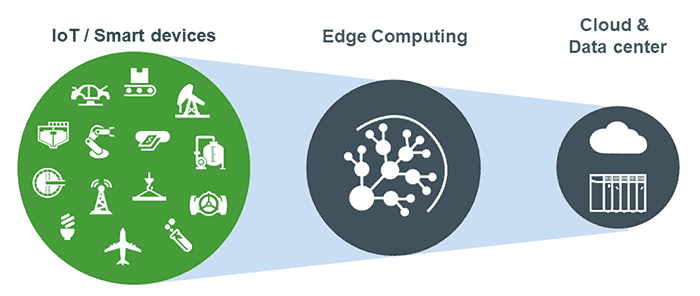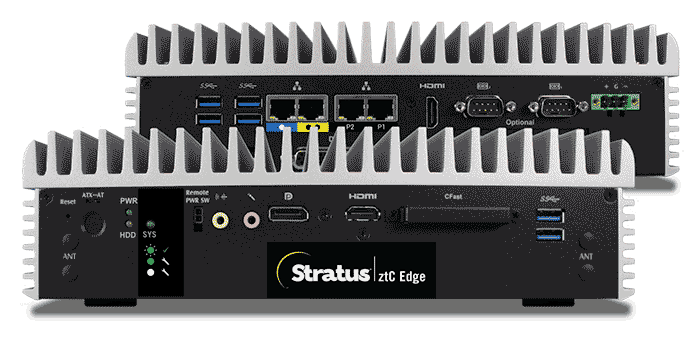In our increasingly competitive economy, companies are looking to digital transformation (DX) as a way to create value and extend competitive advantages through greater efficiencies, new products and services. Among the benefits already seen from DX initiatives, companies can gain unprecedented operational benefits through enhanced visibility into their supply chain, in addition to discovering ways to improve product and service quality. Companies wanting to create a true DX must determine the best ways to connect their intelligent assets and growing numbers of internet of things (IoT) devices. Unfortunately, they often encounter challenges as they merge information technology (IT) and operations technology (OT) systems using software and network technology. But, as DX progresses and technologies converge, information silos break down and bridges can be built to span these networking gaps. These smart and connected devices are often placed at the edge of the network, known as edge computing.
 Image 1. Edge computing describes all computing processes that occur outside of the firm’s core but not on the actual endpoints. (Images courtesy of Stratus Technologies)
Image 1. Edge computing describes all computing processes that occur outside of the firm’s core but not on the actual endpoints. (Images courtesy of Stratus Technologies)Learn the Basics
To put it simply, edge computing describes all computing processes that occur outside of the network core. The edge covers all the space between the core of the network and its endpoints, including infrastructure and devices. This also includes important network gateways that aggregate data and perform preliminary analytics before it is sent to the core for further processing. Pumps and motors are often at the “far edge.” While many may not directly require an edge computing solution, integrating sensors with these systems enables them to more easily connect with edge computing devices, which may be used for control applications along side DX applications, such as predictive maintenance. At the edge, IT operations converge with OT operations. While the border between IT and OT still exists, it is possible to view the edge as a series of concentric IT and OT layers. In fact, the most intelligent edge functions combine these two areas into one common infrastructure for ease of use between the two teams. Properly deployed, an IT/OT convergent edge can address both IT and OT requirements. An intelligent IT/OT edge is capable of hosting both IT applications and OT systems on a common infrastructure layer, enabling a seamless core to edge to endpoint flow.Lose the Hardware
One of the longstanding problems associated with OT networks and endpoint devices is dependence on hardware. These systems can be difficult to change because it means physically replacing devices in the field. This is one of the key reasons intelligent edge development efforts need to shift toward software-defined equipment. A software-focused approach makes it possible to move OT-related control and data acquisition functions to the network so they can be performed both in the core and at the edge. When starting an edge computing initiative, a company has the opportunity to shift its development burden from hardware to software. This provides flexibility to determine whether they want a prepackaged hardware and software solution, with integrated edge computing, or a software that can be deployed on an edge computing platform with other applications. Image 2. Edge servers are capable of operating in potentially dirty or inhospitable environments and must be designed to withstand these physical hazards.
Image 2. Edge servers are capable of operating in potentially dirty or inhospitable environments and must be designed to withstand these physical hazards.Look to Gateways
Efficient data capture and analytics at the edge requires industry-standard gateways for running software. This standardization helps build an ecosystem that OT vendors can use to shift control and data acquisition platforms to these common platforms, which can result in cost savings during DX initiatives. The newest gateways emerging on the market support the convergence of IT/OT edge systems, enabling the growth for intelligent edge capabilities. These gateways must be able to operate in harsh conditions while having the capabilities to deliver industry-standard computing hardware with integrated OT functions, like control and data acquisition capabilities.Choose the Right Device
A proper edge computing strategy must be built on a foundation of industrial-grade computing equipment that is rugged enough to withstand the harsh environments that typically exist at the edge of a network, while consuming minimal IT resources. Edge servers will often be used to manage multiple virtual machines, all running different applications. These systems may also connect to cloud-based self-monitoring services, for easy status monitoring to ensure the uninterrupted operation of business-critical services. When choosing an edge computing server, select devices that:- have high operational efficiencies to shorten the time to get critical applications up and running
- have self-monitoring and self-protecting capabilities to lower risks of unplanned downtime
- offer both IT- and OT-friendly interfaces and operations that support IT/OT convergence at the edge

